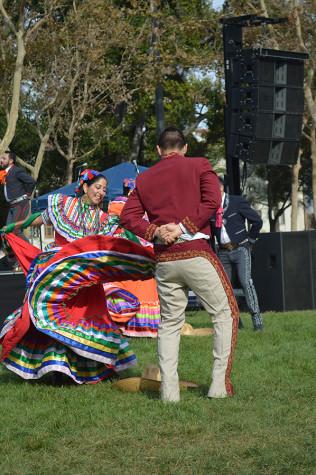A day to honor the dead: San Jose celebration
November 2, 2015
The smell of marigolds and beer, the brightness of yellow and red decor, set the stage for the celebration.
The annual Día de los Muertos (Day of the Dead) festival is a celebration for the Latin cultures to remember the lives of the people who have passed away.
The San Jose Museum of Art hosted its seventh annual Día de los Muertos event at St. James Park in downtown San Jose on Oct. 22. It was not only a celebration, but also a fundraiser for the Chavez Institute for Law and Social Justice.
Volunteers accepted $2 donations at the entrance to raise money for legal services. In exchange, guests received raffle tickets to win prizes.
Entertainment at the event included Luchador Libre (Spanish pro-wrestling) and ancient Aztec dance performance.
As the Luchador wrestlers performed, children cheered and booed with smiles on their faces.
The Calpulli Yaocuauhtli dancers performed in honor of the the Aztec ancestry with the loud sound of drums and rattles. They wore the same attire as was worn during the Aztec era.

Los Lupenos repforms Mexican folk dancing during Dia de los Muertos celebration at St. James Park on Oct.22
A Latin festival would not be complete without a Mariachi band or Mexican folk dancing performed by Los Lupeños de San Jose.
Mariachi Azteca played famous Spanish songs for the folk dancers’ performance, and the crowd cheered. Dancers wore traditional outfits – men in mariachi suits with sombreros and women inbright colored dresses with ruffles and ribbons.
The variety of Spanish dishes, Mexican tacos and sopes and the famous Salvadoran dish of pupusas made the festival more authentic. For refreshments, Agua frescas and beer were served, a perfect combination for a warm day.
The dancers are high school students who joined the Calpulli Yaocuauhtli to expand knowledge of their culture.
“Everyday we are learning more and more about our culture,” said Victor Juarez, founder of Calpulli Yaocuauhtli. “But one thing we must always remember is that we never crossed the border; the border crossed us.”
Besides entertaining the audience, artists displayed their works.
Children designed the sugar skulls and could have their faces painted for free.
The event allowed people to contribute to low income communities and learn more about Hispanic culture and art.
Most importantly, the festival brought families together.

